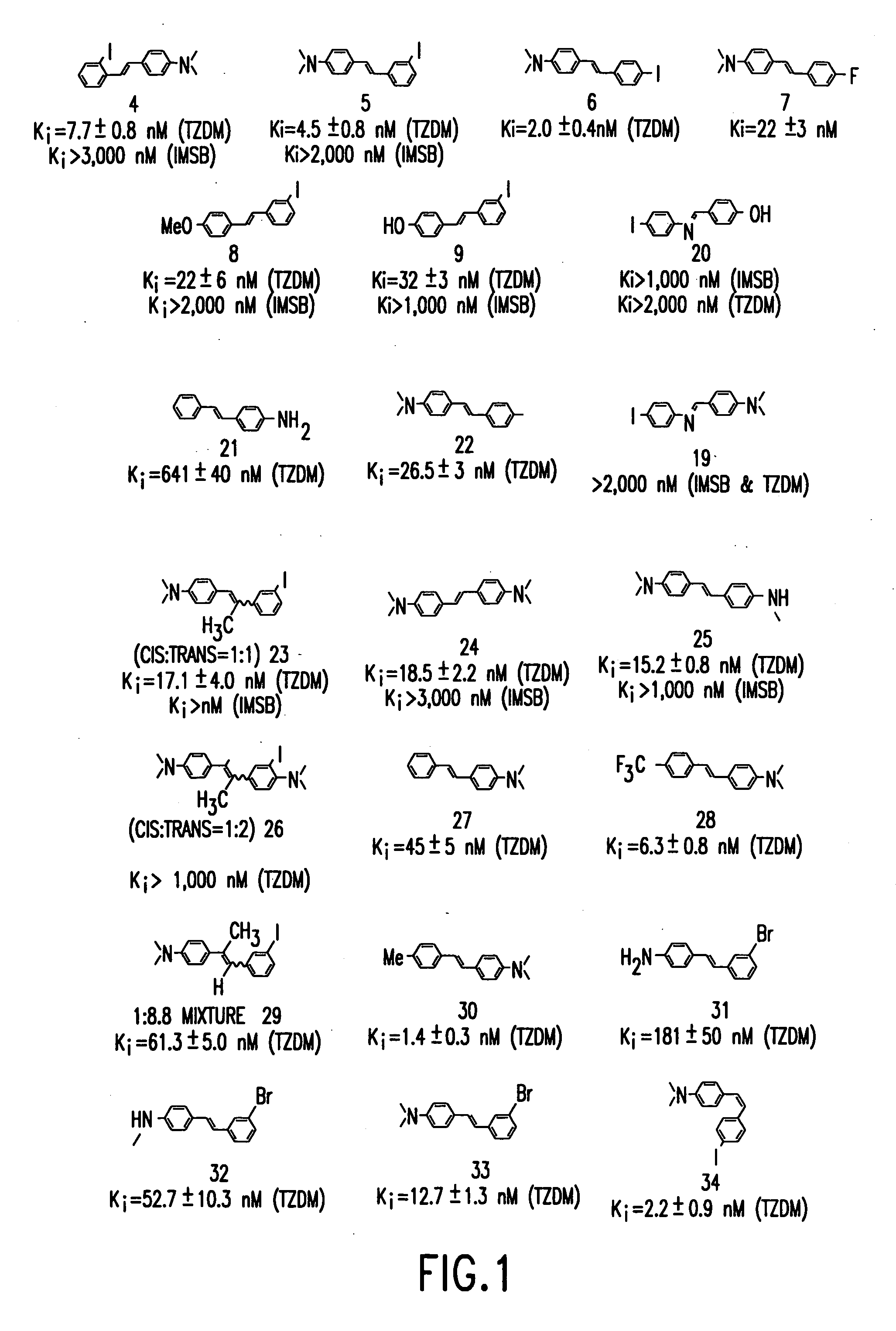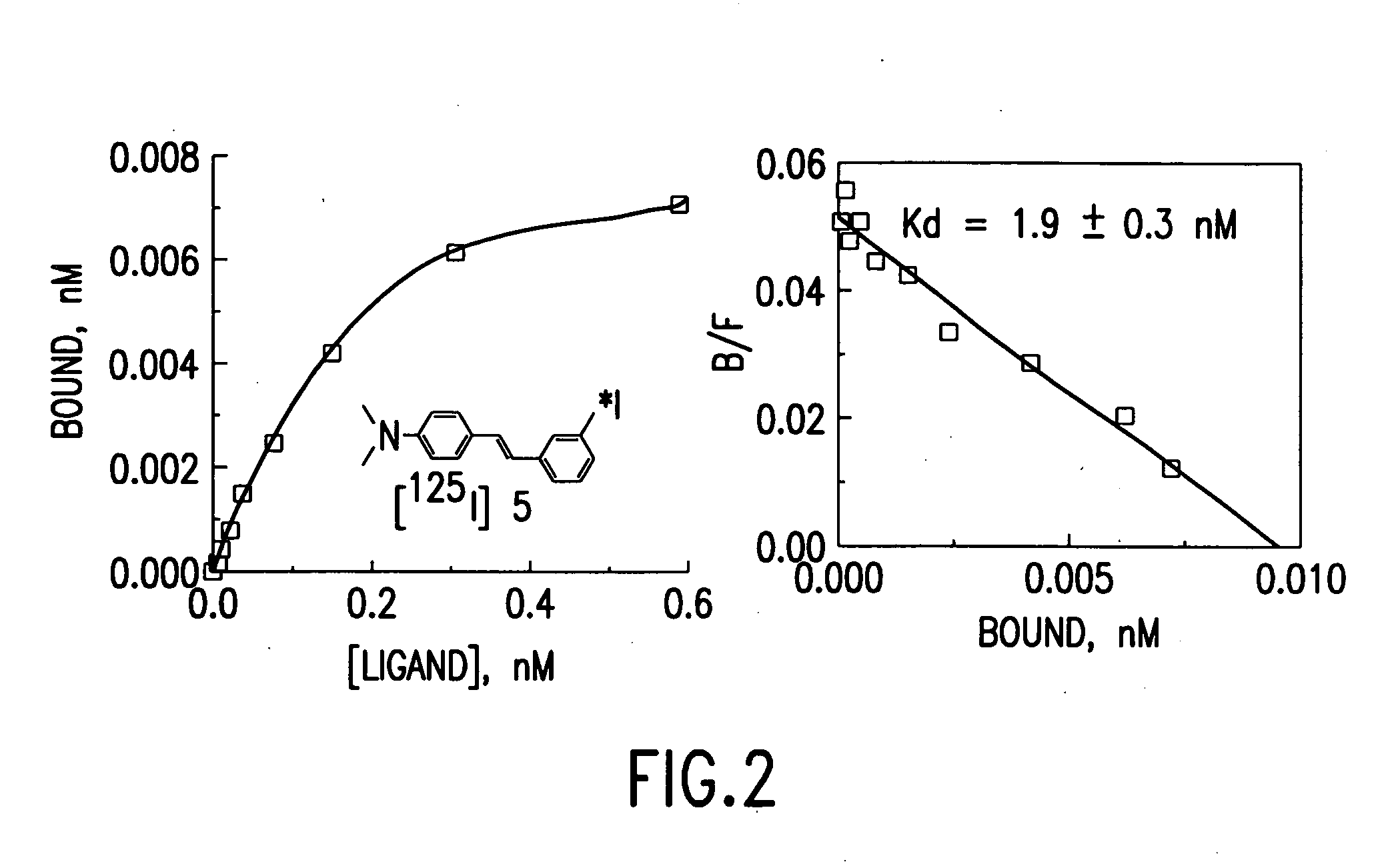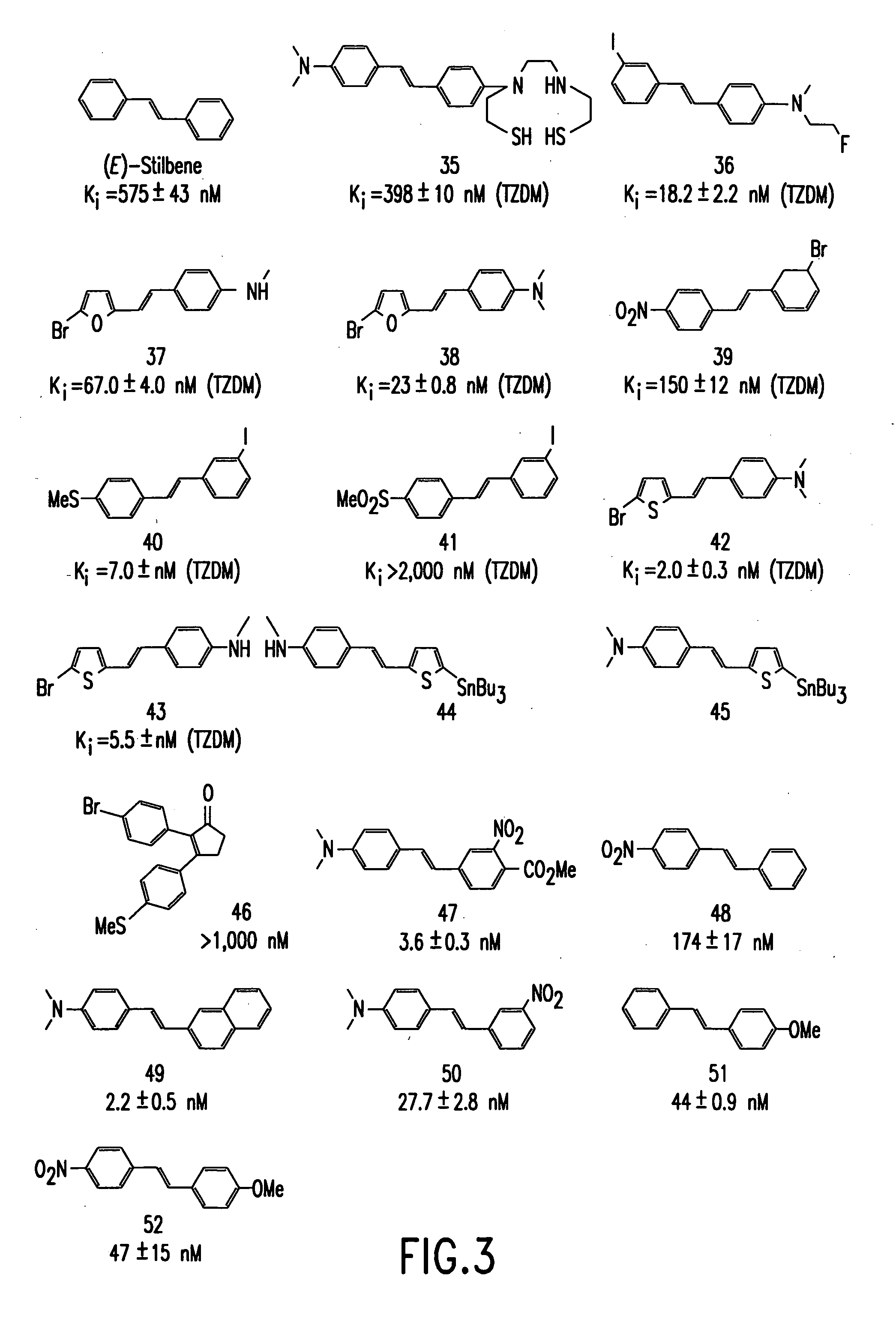Stilbene derivatives and their use for binding and imaging amyloid plaques
a technology of amyloid plaques and derivatives, which is applied in the field of bioactive compounds, can solve the problems of amyloid deposits being difficult to direct imaging in vivo, and amyloid deposits being difficult to imag
- Summary
- Abstract
- Description
- Claims
- Application Information
AI Technical Summary
Benefits of technology
Problems solved by technology
Method used
Image
Examples
example 1
Diethyl 2-iodobenzylphosphonate (11)
[0164] A mixture of 2-iodobenzyl bromide 10 (5 g, 16.84 mmol) and triethyl phosphite (3.3 g, 20 mmol) was stirred at 160° C. After 4 h, the mixture was cooled to room temperature. The residue was subjected to flash chromatography (EtOAc: Hex, 1:4), and gave 2.3 g of 11 (39%). 1H NMR (200 MHz, CDCl3): δ1.24 (t, J=7.04 Hz, 6H), 3.40 (d, J=22.00 Hz, 2H), 4.03 (m, 4H), 6.91 (m, 1H), 7.32 (m, 1H), 7.44 (m, 1H), 7.82 (m, 1H); 13C NMR (50 MHz, CDCl3): δ 16.27 (J=6.00 Hz), 38.31 (J=137.50 Hz), 62.16 (J=6.70 Hz), 101.16 (J=9.45 Hz), 128.23 (J=3.35 Hz), 128.45 (J=3.55 Hz), 130.60 (J=5.10 Hz), 135.36 (J=8.80 Hz), 139.60 (J=2.85 Hz).
example 2
(E)-2′-Iodo-N,N-dimethyl-4-stilbenamine (4)
[0165] To a mixture of NaH (2 mmol, 80% suspension in oil), and 3-iodobenzylphosphonate 2 (500 mg, 1.42 mmol) in 6 mL of THF at 80° C. under nitrogen atmosphere, was added dropwise 4-(dimethylamine)benzaldehyde (210 mg, 1.41 mmol). After overnight at room temperature, NH4Cl solution (saturated, 5 mL) was added and the mixture was extracted with CH2Cl2 (3×30 mL). The combined organic extract was dried over Na2SO4 and evaporated to give (E)-2′-iodo-N,N-dimethyl-4-stilbenamine 11, which was purified by flash chromatography (EtOAc: Hex, 1:9) to give 3 (330 mg, 67%). 1H NMR (200 MHz, CDCl3): δ 3.06 (s, 6H), 6.82 (m, 2H), 6.93-7.02 (m, 1H), 7.01 (d, J=15.98 Hz, 1H), 7.25 (d, J=15.99 Hz, 1H), 7.40 (m, 1H), 7.53-7.59 (m, 2H), 7.69 (dd, J=7.88 Hz, J=1.54 Hz, 1H), 7.95 (dd, J=7.92 Hz, J=1.20 Hz, 1H); 13C NMR (50 MHz, CDCl3): δ 40.26, 100.20, 112.22, 125.12, 125.61, 127.83, 127.87, 127.97, 128.2, 131.66, 139.42, 140.84, 150.23; HRMS: m / z Calcd for C1...
example 3
Diethyl 3-iodobenzylphosphonate (13)
[0166] A mixture of 3-iodobenzyl bromide 12 (5 g, 16.84 mmol) and triethyl phosphite (3.3 g, 20 mmol) was stirred at 160° C. After 4 h, the mixture was cooled to room temperature. The residue was subjected to flash chromatography (EtOAc: Hex, 1:4), and gave 5.4 g of 13 (91%). 1H NMR (200 MHz, CDCl3): δ1.15 (t, J=7.05 Hz, 6H), 2.97 (d, J=21.65 Hz, 2H), 3.92 (m, 4H), 6.93 (t, J=7.76 Hz, 1H), 7.17 (m, 1H), 7.52 (m, 2H); 13C NMR (50 MHz, CDCl3): δ 16.25 (J=5.95 Hz), 33.15 (J=137.60 Hz), 62.19 (J=6.70 Hz), 94.13 (J=3.50 Hz), 128.89 (J=6.35 Hz), 130.07 (J=3.00 Hz), 133.95 (J=9.10 Hz), 135.87 (J=3.55 Hz), 138.51 (J=6.65 Hz).
PUM
| Property | Measurement | Unit |
|---|---|---|
| Capacitance | aaaaa | aaaaa |
| Composition | aaaaa | aaaaa |
| Aggregation | aaaaa | aaaaa |
Abstract
Description
Claims
Application Information
 Login to View More
Login to View More - R&D
- Intellectual Property
- Life Sciences
- Materials
- Tech Scout
- Unparalleled Data Quality
- Higher Quality Content
- 60% Fewer Hallucinations
Browse by: Latest US Patents, China's latest patents, Technical Efficacy Thesaurus, Application Domain, Technology Topic, Popular Technical Reports.
© 2025 PatSnap. All rights reserved.Legal|Privacy policy|Modern Slavery Act Transparency Statement|Sitemap|About US| Contact US: help@patsnap.com



